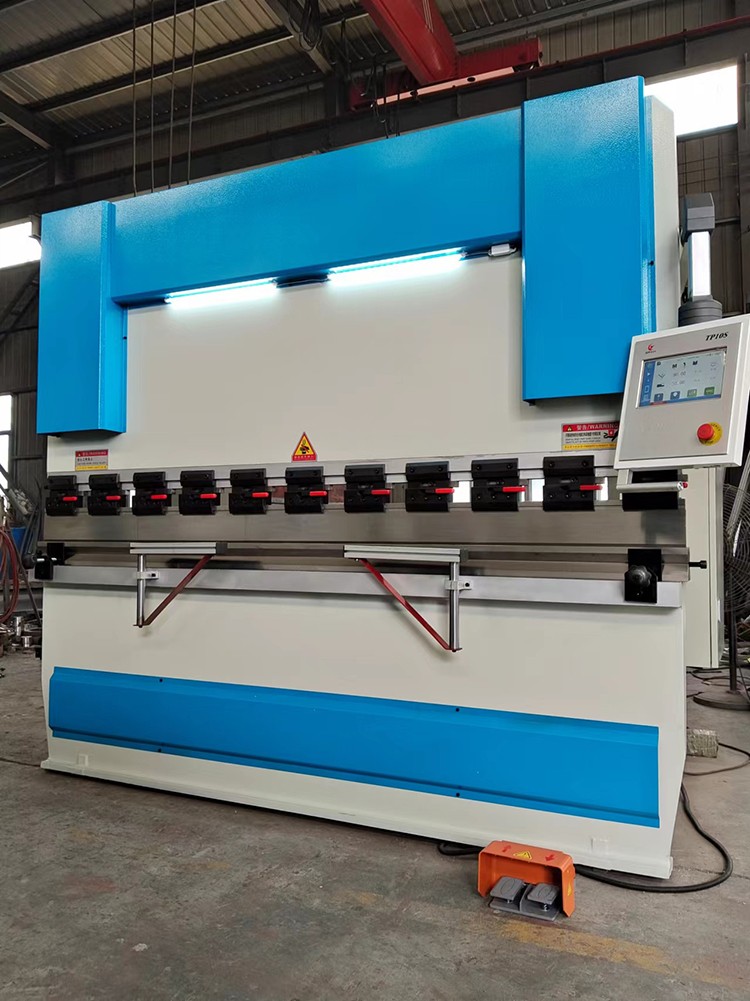

Having earned the trust of thousands of customers through more than 10 years of dedication to the manufacture of bending machines, we will now describe in detail the application of multi-axis linkage in bending machines:

In the modern metal sheet processing field, multi-axis linkage technology has become an important means of improving the performance of bending machines. This technology coordinates the control of multiple motion axes to achieve high-precision processing of complex bending processes. This article will focus on the basic principles, technical advantages, and practical applications of multi-axis linkage.
1, Basic principles of multi-axis linkage
Multi-axis linkage refers to a working mode in which two or more motion axes on a bending machine operate synchronously according to a predetermined program. Typical linked axes include the Y-axis (slide up and down movement), X-axis (backstop forward and backward movement), and R-axis (backstop up and down movement). The control system coordinates the motion trajectories of each axis through algorithms to ensure that the correct relative positional relationship is maintained during the bending process.
The implementation of motion control relies on high-precision servo systems. Each motion axis is equipped with an independent servo motor and encoder, providing real-time feedback on position information. The control system calculates the motion parameters for each axis based on the pre-set bending program, including speed, acceleration, and position. The synchronization error between axes is controlled within 0.1 millimeters to ensure bending accuracy.
2, Technical Advantage Analysis
Multi-axis linkage significantly enhances the processing capabilities of bending machines. By coordinating the movement of the backgauge and slide, complex bends that are difficult to achieve with traditional single-axis control can be completed. For example, when processing workpieces with multi-angle bends, the backgauge can automatically adjust its position according to the bend angle to ensure accurate positioning for each bend.
Improved processing efficiency is another key advantage. Multi-axis interpolation reduces manual adjustment time, enabling multiple bending operations to be completed in a single setup. For mass production, stored processing programs can be used for quick program switching, significantly reducing setup time. Additionally, the increased level of automation lowers the skill requirements for operators.
3, Actual application
In the machining of box-type workpieces, multi-axis linkage demonstrates obvious advantages. When machining electrical control cabinets, the rear stop is adjusted synchronously with the movement of the slide block to ensure the dimensional accuracy of each bent edge. For workpieces that require multiple bends, the system can automatically calculate the material elongation and perform real-time compensation.
Non-standard part processing is a typical application scenario for multi-axis linkage. When processing workpieces with curved bends, the rear stop and slide block move in coordination to achieve continuous variable-angle bending. In the processing of pipe connection parts, multi-axis linkage can precisely control the angle and length of each bend segment to ensure assembly accuracy.
Mold matching is an important part of multi-axis linkage. When using the multi-axis linkage function, it is necessary to select a suitable mold combination. The opening dimensions of the upper and lower molds must match the material thickness to avoid affecting the bending quality due to improper gaps. For special shapes, custom molds may be required.
Operators need to master basic programming methods. Modern bending machines mostly use graphical programming interfaces, where operators only need to input the workpiece dimensions and bending angle, and the system will automatically generate the processing program. For complex workpieces, the CAD drawing import function can be used to reduce programming time. During the program verification stage, it is recommended to use scrap material for trial bending to confirm that there are no errors before proceeding with formal processing.
Maintenance and servicing are critical to maintaining multi-axis positioning accuracy. Regularly inspect the transmission components of each moving axis and promptly replace worn rails and lead screws. Servo motors must be kept clean to prevent dust from affecting heat dissipation. The control system should be calibrated regularly to ensure accurate position feedback for each axis. The lubrication system should be replenished with special lubricating oil on schedule to ensure smooth operation of moving parts.
With the development of intelligent manufacturing, multi-axis linkage technology is evolving toward greater intelligence. The new generation of bending machines has begun to integrate adaptive control functions, enabling automatic adjustment of parameters based on material characteristics. The application of remote monitoring technology allows real-time monitoring of equipment operating status. These technological advances will further expand the application scope of multi-axis linkage and enhance the automation level of metal sheet processing.
If you are interested in bending machines, please contact us.
 Address:Room 1202, Detaitang Building, No. 118 Huaguang Road, Zhangdian District, Zibo, Shandong
Address:Room 1202, Detaitang Building, No. 118 Huaguang Road, Zhangdian District, Zibo, Shandong WhatsApp:+8615653328535
WhatsApp:+8615653328535 Wechat: +8615965331535
Wechat: +8615965331535  E-mail:zs@sdsmachinery.com
E-mail:zs@sdsmachinery.com